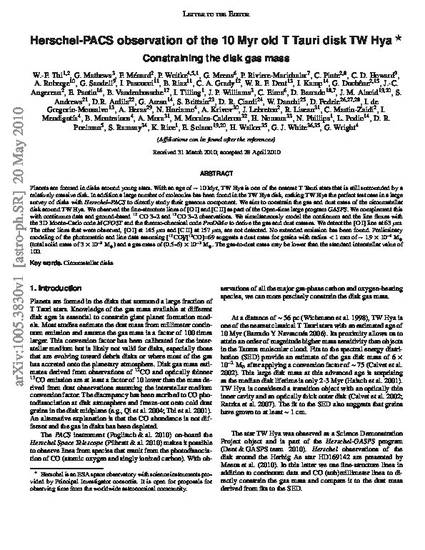
Planets are formed in disks around young stars. With an age of ~10 Myr, TW Hya is one of the nearest T Tauri stars that is still surrounded by a relatively massive disk. In addition a large number of molecules has been found in the TW Hya disk, making TW Hya the perfect test case in a large survey of disks with Herschel–PACS to directly study their gaseous component. We aim to constrain the gas and dust mass of the circumstellar disk around TW Hya. We observed the fine-structure lines of [O i] and [C ii] as part of the open-time large program GASPS. We complement this with continuum data and ground-based 12 CO 3–2 and 13CO 3–2 observations. We simultaneously model the continuum and the line fluxes with the 3D Monte-Carlo code MCFOST and the thermo-chemical code ProDiMo to derive the gas and dust masses. We detect the [O i] line at 63 μm. The other lines that were observed, [O i] at 145 μm and [C ii] at 157 μm, are not detected. No extended emission has been found. Preliminary modeling of the photometric and line data assuming [ 12CO] /[ 13CO] = 69 suggests a dust mass for grains with radius ~1.9 × 10-4 (total solid mass of 3 × 10-3 ) and a gas mass of (0.5–5) × 10-3 . The gas-to-dust mass may be lower than the standard interstellar value of 100.

Additional authors: D. Fedele 26,27,28, I. de Gregorio-Monsalvo 13, A. Heras 29, N. Huelamo 4, A. Krivov 30, J. Lebreton 2, R. Liseau 31, C. Martin-Zaidi 2, I. Mendigutía 4, B. Montesinos 4, A. Mora 31, M. Morales-Calderon 32, H. Nomura 33, N. Phillips 1, L. Podio 14, D. R. Poelman 5, S. Ramsay 34, K. Rice 1, E. Solano 19,20, H. Walker 35, G. J. White 36,35 and G. Wright 4
This manuscript has been published in the journal Astronomy & Astrophysics. Please find the published version here (note that a subscription is necessary to access this version):
http://www.aanda.org/articles/aa/abs/2010/10/aa14578-10/aa14578-10.html
EDP Sciences holds the copyright in this article.